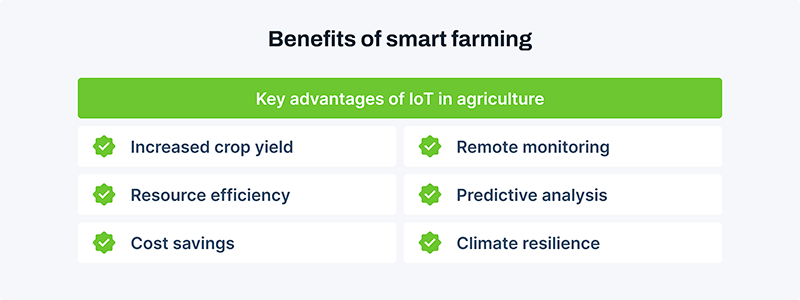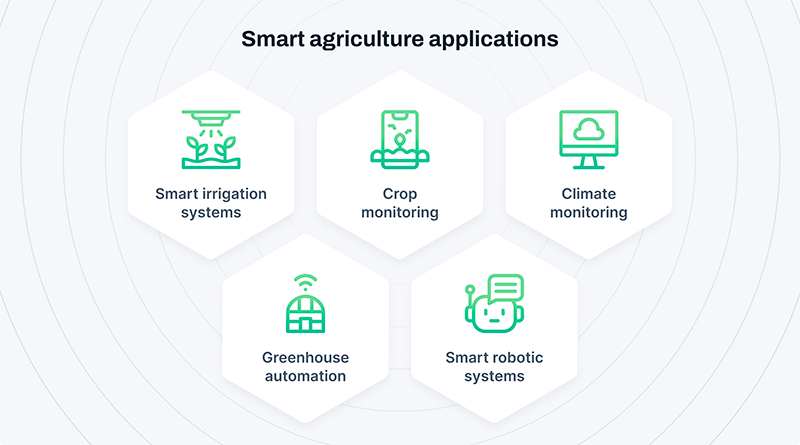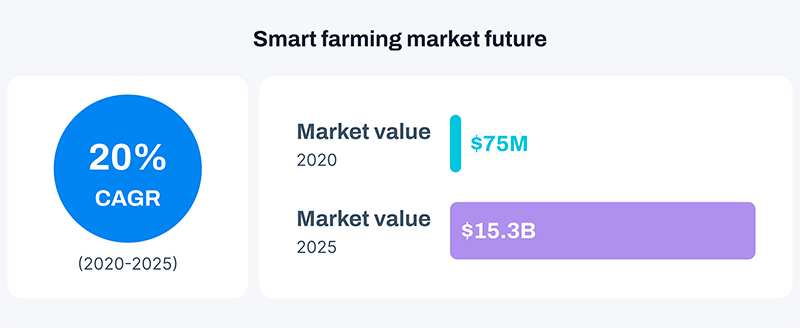Smart farming with IoT integration
February 13, 2024We will discuss smart farming as a transformative approach that integrates advanced IoT agriculture technologies into traditional practices. This innovative farming method leverages the power of smart cloud farming computing, data analytics, and the IoT to optimize crop management, resource utilization, and overall farm efficiency. Smart cloud farming brings precision and intelligence to agriculture, paving the way for sustainable practices and increased yields. Explore the cutting-edge solutions and benefits that smart farming offers to revolutionize the future of agriculture.
What is smart farming?
Smart farming is a modern approach that utilizes advanced technologies like big data, IoT, and the cloud to enhance agriculture. Also referred to as precision agriculture, it involves software-guided and sensor-monitored practices for tracking, automating, and analyzing farming operations. IoT for farming addresses the challenges of the growing global population, high demand for crop yield, efficient resource use, and technological advancements through intelligent and data-driven agricultural management.
IoT for agriculture is revolutionizing the industry by combining information and communication technologies. IoT smart agriculture involves the use of precision equipment, sensors and actuators, geo-positioning systems, unmanned aerial vehicles (UAVs), and robots. IoT technology provides better control over agricultural processes, reducing production risks and improving the ability to predict production results. This allows farmers to plan and distribute products more effectively.
Smart cloud farming is a platform that assists agricultural stakeholders in measuring, monitoring, and visualizing soil and agricultural production on a large scale. The platform uses remote 3D soil monitoring and measurement tools that use satellite images, ground truth data, and artificial intelligence to develop solutions that help farmers make informed decisions about soil management, carbon farming, and regenerative agriculture. By providing accurate and real-time data, smart cloud farming enables farmers to make informed decisions that can help improve their crop yields, reduce their environmental impact, and increase profitability.
Smart farming benefits
Smart farming is a modern approach that aims to make farming more connected and intelligent. It helps in reducing overall costs while improving the quality and quantity of products. This approach also boosts the sustainability of agriculture and the overall experience for the consumer. By increasing control over production, it leads to better cost management and waste reduction. The ability to trace anomalies in crop growth or livestock health helps to eliminate the risk of losing yields. Automation also plays a crucial role in boosting efficiency. With IoT for agriculture, multiple processes can be activated at the same time, and automated services enhance product quality and volume by better controlling production processes.

Increased crop yield
IoT in agriculture is an innovative approach that utilizes advanced technologies to optimize various factors that affect crop growth. By precisely monitoring soil conditions, weather patterns, and crop health, farmers can implement targeted interventions. This includes timely irrigation, optimized fertilization, and early detection of diseases. With the help of data-driven insights and automation, smart farming maximizes the potential for higher crop yields, ensuring efficient resource utilization and promoting sustainable agricultural practices.
Resource efficiency
IoT smart agriculture involves using technology to manage resources in a precise manner. Inputs such as water, fertilizers, and pesticides are managed through sensors and smart cloud platforms. This helps farmers gain insights into soil moisture levels, nutrient content, and pest infestations. With this information, they can apply resources only where and when needed, reducing waste and minimizing environmental impact. By optimizing resource efficiency, smart farming promotes sustainable agricultural practices, reduces operational costs, and mitigates the ecological footprint. This contributes to long-term environmental conservation and ensures the responsible use of resources in the farming sector.
Cost savings
IoT in agriculture has become a game-changer for farmers, offering significant cost savings. IoT devices, sensors, and data analytics in precision agriculture help farmers make informed decisions on resource allocation, which ultimately reduces unnecessary expenditures. By accurately monitoring soil conditions, weather patterns, and crop health, farmers can optimize the use of inputs such as water, fertilizers, and pesticides.
This targeted approach minimizes waste, lowers operational costs, and increases overall efficiency. Moreover, automation in farming processes, such as robotic harvesting or autonomous machinery, reduces labor costs. By streamlining operations and maximizing resource utilization, smart farming leads to substantial cost savings, thereby enhancing the economic viability of agricultural practices.
Remote monitoring
Smart cloud farming introduces remote monitoring capabilities that allow farmers to supervise their operations from any location. With IoT for agriculture sensors and devices, farmers can monitor essential factors such as soil moisture, temperature, and crop health in real time. The integration of smart cloud farming enhances accessibility to data and analytics.
Smart cloud farming solutions store and process vast amounts of agricultural data, providing farmers with actionable insights. This helps farmers make informed decisions, allowing them to adapt strategies based on comprehensive data analysis. The combination of remote monitoring and smart cloud farming not only improves efficiency but also promotes sustainable and data-driven agricultural practices, contributing to increased productivity and environmental stewardship.
Predictive analysis
Predictive analytics use historical data, real-time information, advanced algorithms, and predictive analytics to help farmers anticipate various aspects of agricultural processes. This includes predicting crop yields, identifying potential pest infestations, optimizing irrigation schedules, and anticipating weather patterns. With predictive analysis, farmers can make proactive decisions to mitigate risks, enhance resource allocation, and maximize productivity.
This forward-looking approach empowers farmers to respond to challenges before they escalate, leading to more efficient and sustainable agricultural practices. Cloud farming's predictive capabilities contribute to better-informed decision-making and improved overall farm management.
Climate resilience
IoT for farming is a critical component in improving climate resilience for agricultural practices. With the effects of climate change on weather patterns and extreme weather events, farmers are facing additional challenges. By incorporating smart cloud farming technologies, data analytics, and IoT, real-time insights can be gathered about weather conditions, soil health, and crop performance. This information enables farmers to adjust their practices based on changing environmental conditions, ensuring better resilience to climate variations.
Smart farming technologies
IoT in agriculture uses various types of technologies, from sensors to robots and drones. Here are some of them:
Sensors
Cloud farming relies on farming sensors to provide real-time data on crucial parameters. These sensors monitor soil moisture, nutrient levels, temperature, and weather conditions. By leveraging IoT technology, farmers can make data-driven decisions, optimize resource use, and enhance overall crop management. The data collected from these sensors contributes to precision agriculture, and fosters increased efficiency.
Telecommunication
Smart farming telecommunications have a significant role in connecting devices and enabling seamless data exchange in agriculture. Smart farming telecommunications facilitate real-time monitoring, control, and data transmission by utilizing advanced communication technologies, such as 5G and IoT. This ensures farmers can manage their equipment remotely, receive instant updates on crop conditions, and implement precision farming techniques.
The integration of cloud farming with robust telecommunication networks enhances operational efficiency, accelerates decision-making, and contributes to sustainable and technologically advanced agricultural practices.
Robotics in agriculture
In the Industrial Revolution, automation progressed to handle complex tasks and increase productivity. In the face of global labor shortages, agriculture robots, also known as robots, are becoming more prevalent. Recent advancements in sensors and AI enable machines to learn from their surroundings, making robots even more useful. We are currently in the early stages of an ag-robotics revolution, exploring the full potential of the IoT in agriculture.
Satellites and drones
Smart farming involves the use of drones and satellites to achieve precision agriculture. Drones equipped with cameras and sensors are used to monitor the health of crops, assess field conditions, and optimize irrigation. Meanwhile, satellites provide real-time imagery, enabling farmers to monitor large areas of crops. This aerial perspective enhances crop management, minimizes resource use, and boosts overall farm efficiency. The integration of smart farming with drone and satellite technology represents a futuristic approach to sustainable and technologically advanced agriculture.
Smart cloud farming system
Smart cloud farming is an innovative agricultural approach that leverages cloud computing technology to enhance and streamline farming operations. It involves the integration of various smart technologies, including the IoT, data analytics, and remote sensing, all managed and accessible through cloud-based platforms. This interconnected system allows farmers to monitor and manage their agricultural processes, such as crop cultivation, irrigation, and resource utilization, in real-time from any location with internet access.
Smart cloud farming aims to optimize efficiency, improve decision-making, and promote sustainable and precision agriculture practices through the seamless integration of digital tools and cloud-based solutions.
Challenges IoT in agriculture
Cost of installation
Implementing IoT in agriculture demands a significant upfront investment, covering expenses for essential equipment like sensors, drones, and smart farming platforms. This financial commitment may pose challenges, especially for organizations operating within budget constraints. Moreover, the diverse nature of agricultural operations could necessitate specialized hardware, potentially escalating costs, especially when bespoke solutions are essential.
Despite these challenges, the long-term benefits of improved efficiency, resource optimization, and data-driven insights make IoT adoption a strategic investment for the evolving agricultural landscape.
Security and privacy
When integrating IoT in agriculture, prioritizing data security is essential. Protection measures must safeguard sensitive information, like crop yields and irrigation schedules, ensuring exclusive access for authorized personnel. Robust defenses against cyber threats are imperative to prevent unauthorized access and potential exploitation. Furthermore, a stringent commitment to customer privacy is vital to complying with global regulations on personal data protection.
While challenges such as cost and cybersecurity persist, the judicious implementation of IoT technology promises significant benefits for agriculture, enhancing efficiency and sustainability when executed with diligence and adherence to security protocols.
Smart agriculture applications

Smart irrigation systems
Smart irrigation systems have revolutionized traditional farming practices by integrating technology and optimizing water usage, enhancing crop yield and reducing environmental impact. These systems use sensors, weather forecasts, and data analytics to determine precise irrigation schedules. By monitoring soil moisture levels, temperature, and other factors, smart irrigation adapts watering patterns to specific crop needs, preventing over-watering and minimizing water waste.
Automated controls enable remote management, empowering farmers to adjust settings using mobile apps. Smart irrigation systems contribute to sustainable agriculture, ensuring efficient water utilization for optimal crop growth.
Crop monitoring
Crop monitoring IoT systems use sensors, cameras, and data analytics to provide real-time insights into crop conditions. These systems collect data on soil health, moisture levels, temperature, and crop growth. IoT sensors deployed in the fields transmit information to a central platform, allowing farmers to monitor and analyze the data remotely.
This technology enables farmers to make informed decisions about irrigation, fertilization, and pest control. With continuous monitoring, crop monitoring IoT systems contribute to improved yield, resource efficiency, and sustainable farming practices.
Climate monitoring
IoT for agriculture monitoring systems combines sensors, connectivity, and data analytics to keep track of various farming aspects. These systems use sensors to gather data on soil conditions, weather patterns, crop health, and equipment status. The collected data is transmitted to a central platform through IoT connectivity. With real-time data, farmers can make informed decisions, improve efficiency, optimize resource usage, and contribute to sustainable agriculture practices. Through continuous monitoring, IoT-based agriculture systems provide farmers with actionable insights for better crop management and overall farm productivity.
Greenhouse automation
IoT agriculture greenhouse automation involves the use of sensors and connected devices to automate and optimize greenhouse operations. These systems monitor environmental factors such as temperature, humidity, and light and adjust them in real-time for optimal plant growth. Through IoT technology, farmers can control and monitor their greenhouse conditions remotely, accessing data from anywhere.
Greenhouse automation enhances efficiency, reduces resource waste, and ensures consistent crop quality. By leveraging IoT, farmers can create an intelligent and connected environment, fostering sustainable and precise agriculture practices within greenhouse cultivation.
Smart robotic systems
Automated machine navigation controllers, tractors, and heavy plowing equipment can now be controlled remotely through GPS. These machines are integrated and precise, and they self-adjust to different terrains, streamlining labor-intensive tasks. Their movements and progress can be easily monitored through smartphones. Advancements in IoT and machine learning enable these tech-driven motors to facilitate advanced farming independently, featuring automatic obstacle detection.
Robots are used for crop picking to address labor shortages and can operate 24/7. These innovative machines delicately pick fruits and vegetables using a combination of image processing and robotic arms, ensuring quality control. Early focus on robot harvesting is seen in orchard fruits like apples due to high operational costs. Greenhouse harvesting for high-value crops such as tomatoes and strawberries is also optimized by these bots, determining crop stages and harvesting at the right time.
Robots play a crucial role in handling manual labor tasks alongside human workers. They can lift heavy materials and perform activities like plant spacing with high accuracy, optimizing space and plant quality and reducing production costs in agriculture.
Smart farming market future
As the world population continues to rise rapidly, the demand for food is projected to increase by 70% in 2050. This presents a significant challenge due to shrinking agricultural lands and depleting natural resources. The limited availability of resources such as water and arable land, combined with a declining agricultural workforce, has resulted in the adoption of internet connectivity solutions in farming. The aim is to reduce the reliance on manual labor and address these challenges effectively.
The agriculture industry is set to experience significant growth. According to the BI Intelligence survey, this growth is expected to triple the global smart agriculture market to $15.3 billion by 2025, compared to just over $5 billion in 2016, with a compound annual growth rate of 20%.

With the help of IoT technologies, smart farming enables farmers to optimize productivity and minimize waste in various aspects, including the usage of fertilizers and farm vehicle journeys. The technology helps in the efficient utilization of resources, such as water and electricity.
IoT smart farming solutions incorporate sensors to monitor crop fields, which includes monitoring light, humidity, temperature, soil moisture, and crop health, as well as automating irrigation. This enables farmers to monitor field conditions remotely and choose between manual and automated actions based on real-time data. For instance, if the soil moisture decreases, sensors initiate irrigation. Compared to traditional methods, smart farming proves to be highly efficient.
Conclusion
In summary, smart farming, powered by IoT integration, leads the charge in agricultural innovation, providing precision, efficiency, and sustainability. The progression to smart cloud farming enhances these advantages, utilizing advanced technologies to optimize resource use, improve data analytics, and bolster resilience amid evolving agricultural environments.
This comprehensive approach not only tackles current challenges but also charts a course for a connected, data-driven future, fostering more efficient, productive, and eco-conscious agriculture. Smart farming, coupled with smart cloud solutions, signifies a transformative path toward a technologically advanced and resilient agricultural sector.
FAQ
What is smart cloud farming?
Smart cloud farming integrates IoT and cloud technologies in agriculture, optimizing resource management, enhancing data analytics, and ensuring resilience. It enables farmers to make data-driven decisions for efficient, sustainable, and connected farming practices.
What is the role of the cloud in smart agriculture?
The cloud in smart agriculture stores and analyzes data from various sensors and devices on farms. It helps farmers make informed decisions, like when to plant or irrigate, by providing real-time insights accessible from anywhere.
What is IoT-based smart agriculture?
IoT in smart agriculture uses technology like sensors and drones to gather data from fields. This data helps farmers make informed decisions on things like irrigation, fertilization, and pest control, ultimately improving crop yields and efficiency.
What are the applications of smart farming?
Smart farming apps help farmers manage crops, livestock, and resources more efficiently. They monitor soil conditions, weather forecasts, and animal health, optimizing production and reducing waste.
